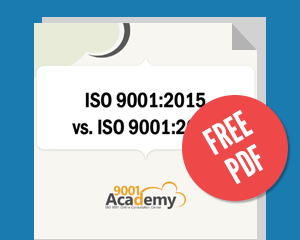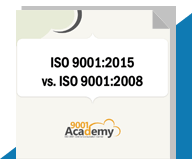The new 2015 revision of ISO 9001, the leading international standard for designing and implementing a Quality Management System, is finally in front of us. As the much-anticipated standard comes into being, now we can see what has really changed in the new version.

To get a better overview of the differences between the two revisions, see this free ISO 9001:2015 vs. ISO 9001:2008 matrix
History of Quality Management System standards
ISO 9000 was first published in 1987. It was based on the BS 5750 series of standards from BSI that were proposed to ISO in 1979. However, its history can be traced back some 20 years before that, to the publication of the United States Department of Defense MIL-Q-9858 standard in 1959. MIL-Q-9858 was revised into the NATO AQAP series of standards in 1969, which in turn were revised into the BS 5179 series of guidance standards published in 1974, and finally revised into the BS 5750 series of requirements standards in 1979 before being submitted to ISO. The first revision was done in 1994, and the standard was issued as a quality assurance system. At this point, the standard had three sub-standards: ISO 9001, ISO 9002, and ISO 9003. The next revision of the standard was done in the year 2000, and this standard defined the Quality Management System. In 2008 the third revision was published, and now the 2015 revision is the current revision.
Alignment
The new version of ISO 9001 is aligned with Annex SL, which makes it more compatible with other management systems standards like ISO 14001, ISO 22301, ISO 27001, and ISO 20000, and makes the integration even easier. See also: Integrating ISO 9001 and ISO 14001.
Transition period
Companies certified against the 2008 revision of ISO 9001 must transition to the new version by September 2018. But don’t be fooled by this loose deadline; lead certification bodies have announced plans to stop certification against the 2008 revision in September 2016, which means that you can be certified against the old version in the next year and have your last surveillance audit in 2018. But, why wait for so long? Companies can get certified against the new version beginning in September 2015.
Comparison
There are now seven principles instead of the eight in the 2008 revision, but the essence is the same. The new version has 10 instead of the eight clauses in the old version, and instead of six mandatory procedures, there are now six mandatory documents that don’t have to be in the form of a procedure. This can be little confusing at the beginning, but the intention was to provide more liberty in documenting the Quality Management System. See also: ISO 9001:2015 vs. ISO 9001:2008 matrix.
Requirements
There are some new requirements, but the most significant are Context of the organization (Clause 4) and Actions to address risks and opportunities (Clause 6.1). The idea behind these new requirements is to incorporate the QMS in everyday business activities. Some old requirements are history now: the management representative and preventive actions are no longer part of ISO 9001, although they can be kept by the organizations. See also: How to identify the context of the organization in ISO 9001:2015 and Risk-based thinking replacing preventive action in ISO 9001:2015 – The benefits.
ISO 9001:2008 vs 2015 – Similarities and differences
Different parts of the standard have seen different levels of changes. Quality Policy, Leadership, Competence, Training and awareness, Management review, Internal audit and Corrective action had only slight changes, and most of the existing QMS related to these requirements can remain as it was. The second group, which has moderate changes, includes Control of externally provided processes, products and services; Quality objectives and plans for achieving them; Performance evaluation; Document management; Production and service provision; and QMS Scope, and these elements should be revised and updated to be compliant with the new revision of the standard.
There is also a group of new requirements that has to be established and incorporated into the existing QMS from scratch. Risks and opportunities, Context of the organization, and Interested parties are new requirements that need to be met, and they should be implemented with caution because they cast a completely new light on the Quality Management System.
What do the ISO 9001:2015 changes bring to the QMS?
This version of the standard was the most anticipated one, because it introduces very significant changes in approach and in the concept of the QMS. It also brings many challenges for implementation, transition, and maintenance of the QMS, but if everything is done as it should be, ISO 9001:2015 will bring to your QMS:
- Better integration with other business activities
- Enhancement of the process approach and PDCA cycle
- Decentralization of the system and spread of responsibilities for the QMS throughout the organization
- Greater involvement of the top management in the QMS
- Introduction of risk-based thinking in the QMS
- Higher emphasis on performance monitoring
The new version of the standard gives us a new chance for improvement of the QMS, and it is up to us to seize that opportunity. Click here to watch a recording of the webinar ISO 9001:2015 vs. ISO 9001:2008 – The main changes to learn more details about the differences between these two revisions.

 Strahinja Stojanovic
Strahinja Stojanovic 




